#thoughtprovoker
Text
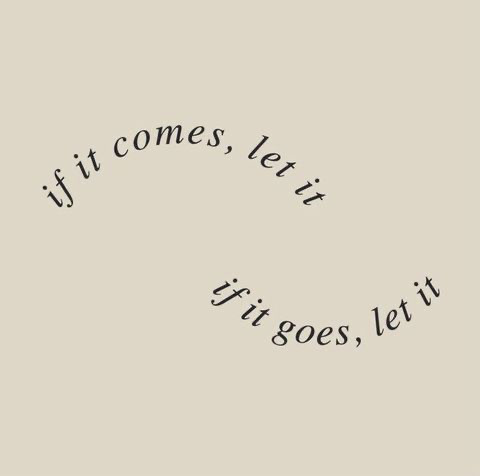
#quotes#inspiration#motivation#wisdom#lifequotes#lovequotes#successquotes#positivequotes#famousquotes#thoughtprovoking#wordsofwisdom#quoteoftheday#quotestoliveby#inspiringwords#motivationalquotes#deepthoughts#meaningfulquotes#lifeisbeautiful#nevergiveup#alwaysbelieve#yougotthis#positivevibes
328 notes
·
View notes
Text

“Jesus came to seek and save us. He laid aside his glory and majesty to come as a humble baby. He went on to live in submission to his parents, to learn, grow up, teach, serve, suffer, and die for us. Everything he did was for us.”- Mike Henry Sr.
20 notes
·
View notes
Text
the worst thing about that giovannis room quote is the place in the book where it comes like. its all over by then. i mean yes its over before its even begun because of david as a person but. like it doesnt even come at the start when david is lying to himself and pretending to ignore the clock ticking on their situation and eating cherries. by the time and will you bring me home again / yes i'll bring you home again comes about its as good as done and so giovanni is as good as done his fate is sealed and david is halfway out the door promising to bring him home like. pages b4 that when giovanni loses his job he goes if you were not here this would be the end of giovanni. and LINES before he says it he's going i do not know what i would do if you left me. i do not think i would be able to live if i had to be alone again. and david knows he's gone! he's already in the process of leaving giovanni to be alone again! they're not even at the beginning of the end theyre practically in the middle of it! the end of them and the end of giovanni because they're one and the same! giovanni tells him that when david leaves he will not be able to live. and then he asks him if he will bring him home again to this room that david knows that he is going to leave (<- and in doing so he is going to bring about the end of giovanni. and the end of himself). girls giovanni is practically dead already. and knowing what he is going 2 do to him david goes. yes. ill bring you home again.
#rest assured im saying nothing thoughtprovoking nor of depth or value here sorry im just losing my mind every time i see that#line on the dash i get a giovannis room induced stomach ache. that fucking book. that fucking book has ruined me for all other#books..........and there are like. 4 or 5 lines in there that take years off my life every time i read them and. this one is at the very#top sorry and will you bring me home again / yes. ill bring you home again is the worst thing ive ever read in my life it makes#me dry heave. sorry please no one read this this whole post is just me repeating an obvious statement over and over again it is 11pm#i just. have to make a post like this every few months for my own wellbeing or the doctors say my ribs will burst out of my chest....#giovanni's room
27 notes
·
View notes
Quote
When is a monster not a monster? Oh when it is loved
Pinterest
#love#loveeveryone#quotesoflife#monsters and heroes#two sides of the same coin#heroes and villains#tolove#unconditionallove#quotes#thoughtprovoking#lifequotes#relations#pinterestquotes#pinterest#people#life#lifemakesusmonsters#love is war#thoughts#Thought For The Day#bekind#youmatter#embraceeveryone#quote#poeticworld#literature
62 notes
·
View notes
Text
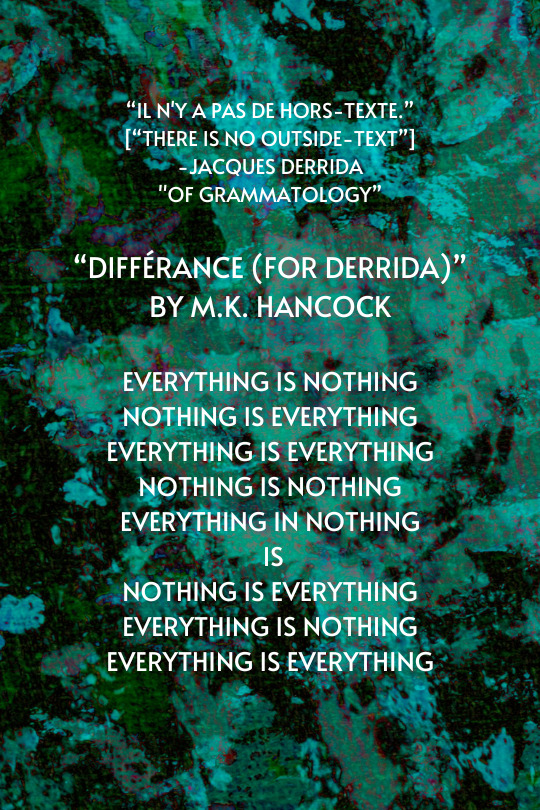
“Il n'y a pas de hors-texte.”
[“There is no outside-text.”]
- Jacques Derrida, "Of Grammatology"
In this exploration of Derrida's notion of "Différance," the lines of my poem are a meditation on the fluidity of meaning and the illusory boundaries between opposites:
Différance (for Derrida)
by M.K. Hancock
Everything is nothing
Nothing is everything
Everything is everything
Nothing is nothing
Everything in nothing
is
Nothing is everything
Everything is nothing
Everything is everything
As we delve into the texture of experience and the fabric of existence, I invite you to reflect and share your thoughts on how these concepts resonate with your understanding of the world.
#poets on tumblr#artists on tumblr#thoughtprovoking#literature#writers on tumblr#writing#philosophy#poetry#jacques derrida#modern poetry#poststructuralism#existentialism#deconstruction#poem#original poem
3 notes
·
View notes
Text
Adam Sills’s well-written and beautifully produced Against the Map is in some ways a strange book to review [...] [from the disciplinary perspective of environmental studies]. Sills shows little interest in environmental history or ecocriticism, even in the “ecology without nature” mode [...]. His basic argument is that cartography, because of print capitalism, seeped into all sorts of facets of life on the British Isles during the late seventeenth and eighteenth centuries. It became something that playwrights, novelists, and creative nonfiction types, like Samuel Johnson, developed spaces of resistance to in their publications. Sills highlights the political nature and problematic historical genealogies of maps, an argument that has broader implications for [contemporary] environmental historians who use maps to convey [relatively more “objective” and/or “scientific” information] [...].
Sills begins by accepting the idea, derived from Ben Anderson’s comparative work, that “the history of the map and the history of the modern nation state are inextricably bound up with each other” (p. 1). He then cites two of the key analysts of this in relation to Britain: Richard Helgerson on the literary nationalism of the English Renaissance and John Brewer on the fiscal-military state of the eighteenth century, with its army of surveyors and excise tax collectors. In this historiography, the “surveyor emerges as an authorial figure,” key to the making of the modern state as distinct from traditional dynastic and ecclesiastical authority (p. 3). Combined with cheap printing, the result was what Mary Pedley has called a “democratization of the map” (p. 4). [...]
---
For John Bunyan, the “neighborhood” became a site of resistance (as it is for Denis Wood in his 2010 Everything Sings: Maps for a Narrative Atlas). [...]
For Aphra Behn, [...] the theater and “built environment” of the “fragmented, chameleonlike ... scenic stage” had the ability to challenge coherent representations of the Atlantic empire produced by maps like those of world atlas publisher and road mapper John Ogilby (p. 65).
From Dublin, Jonathan Swift directly satirized the cartographic and statistical impulses of the likes of William Petty, Henry Pratt, and Herman Moll, who all helped visualize London’s colonial relationship with Ireland [...].
From London, Daniel Defoe questioned efforts to define what precisely makes a market or market town through maps and travel itineraries, pointing toward the entropic aspects of the market (“its inherent instabilities and elusive nature”) that challenged and escaped efforts to stabilize such spaces through representations in print (p. 163).
Johnson’s travels to Scotland redefined surveying, resisting the model put forward by the fiscal-military state in the aftermath of the Jacobite Rebellion of 1745.
---
The final chapter and conclusion, “The Neighborhood Revisited,” looks at Jane Austen’s Mansfield Park (1814), a classic novel of the artificial environment of the estate garden. By the early nineteenth century, neighborhoods were more like gated communities and symptomatic of Burkean conservatism and nostalgia. But in Austen’s hands, their structures of affect also suggest the limits of the controversial map- and data-centric literary methodologies [...] and perhaps more broadly the digital humanities. “The principle of spatial difference and differentiation, the heterotopic conceit, always remains a formal possibility, not only at the margins of the empire but at its very center as well,... a possibility that the map cannot acknowledge or register in any fashion” (p. 234). For Sills, this is true of eighteenth-century mapping as well as the fashion for “graphs, maps, and trees” in the early twenty-first century.
---
Sills’s basic argument, that a certain canonical strain of English literature - from Bunyan to Austen - positioned itself “against the map,” seems quite solid. He makes this point most directly by appealing to the work of Mary Poovey on the modern “fact,” with the map as “a rhetorical mode ... that serves to legitimate private and state interests by displacing and, ultimately, effacing the political, religious, and economic impact of those interests” (p. 91).
Nevertheless, returning to a[n] [exclusively] canonical, Bunyan-centered, “small is beautiful” neighborhood approach [potentially ignoring planetary environmental systems, the global context, in cartography] seems limited and problematic from the perspective of Anthropocene [...]. The global maps and mathematics used by the likes of Edmund Halley and Isaac Newton, which were directly satirized by Swift in the Laputa section of Gulliver’s Travels (1726), did something different than Petty’s mapping of Ireland. High-flying as they may have been, such maps and diagrams were key to the development of [...] environmental thinking by Charles Darwin, Charles Lyell, Alexander von Humboldt, and others in the nineteenth century. More recently, global mapping [...], like the internet closely tied initially to the modern American fiscal-military state, have [also later then] been essential to identifying processes of climate change, ocean acidification, deforestation, dead zones, sea level rise, desertification, and a host of other processes that would otherwise be challenging to perceive. This is no mere “Vanity Fair.” Sills’s book would have benefited from engaging with Jason Pearl’s Utopian Geographies and the Early English Novel, published in 2014 [...]. Pearl also does close readings of Behn, Defoe, and Swift, choosing Margaret Cavendish instead of Bunyan and stopping in 1730, just before things became picturesque but just after they were financialized by the South Sea Bubble, Newton’s mint, and Robert Walpole. Pearl reproduces maps by Defoe of Robinson Crusoe’s global travels and of Crusoe’s island, Swift of Houyhnhnmland, Ambrosius Holbein of Thomas More’s Utopia [...].
What if rather than “against the map,” we are seeing struggles between radical and conservative cartography [...] engaged in a fight over the future (utopia)?
What if what [...] [some have] called “capitalist realism” [...], what might in the eighteenth century be called “nationalist realism,” is not the only thing happening with maps and the imagination?
---
Text above by: Robert Batchelor. “Review of Sills, Adam, Against the Map: The Politics of Geography in Eighteenth-Century Britain.” H-Environment, H-Net Reviews. May 2023. Published online at: h-net,org/reviews/showrev,php?id:58887. [Bold emphasis and some paragraph breaks/contractions added by me. In this post, all italicized text within brackets added by me.]
#hmm lot going on here pretty thoughtprovoking for a review#i have lots of thoughts about radical potential of maps for conception of planetary scale and antiimperialism#though simultaneously must remain critical of panopticon aerial perspective of satellite imagery as batchelor says originating with usempire#to acknowledge radical alternatives to imperial mapping in nineteenth century#instead of namedropping humboldt and darwin and chauvinist racist figures i wouldve pointed to#exslaves and abolitionists and their use of global scale conceptions to frame revolutionary atlantic and international solidarity#anyway#abolition#ecology#colonial
18 notes
·
View notes
Text

DO YOU DISAGREE?👂🏾
Get TWICE as many UNPUBLISHED aphorisms (“quotes”) of mine (for FREE, via my online School for Students of Life) than I share here: mokokoma.com/more 🧠
#quote#quotes#quotation#quotations#aphorisms#aphorism#sayings#wisdom#foodforthought#thoughtprovoking#quoteoftheday#stoicism#pessimism#satire#sarcasm#humour#humor#funny#realtalk#wordsofwisdom#philosophy#criticalthinking#socialcriticism#words of wisdom#social criticism#real talk#critical thinking#food for thought#quote of the day#thought provoking
17 notes
·
View notes
Text

Embrace the chaos and find your focus. This is about the paradox of life: an inevitable end gives meaning to the present. Let's remember what truly matters. 🌟
#HandmadeArt#InkAndRubber#LifeQuotes#SilverStar#MeaningOfLife#MementoMori#FocusOnWhatMatters#ArtisticExpression#ThoughtProvoking#EmbraceTheChaos#mel vil#villemel
2 notes
·
View notes
Text
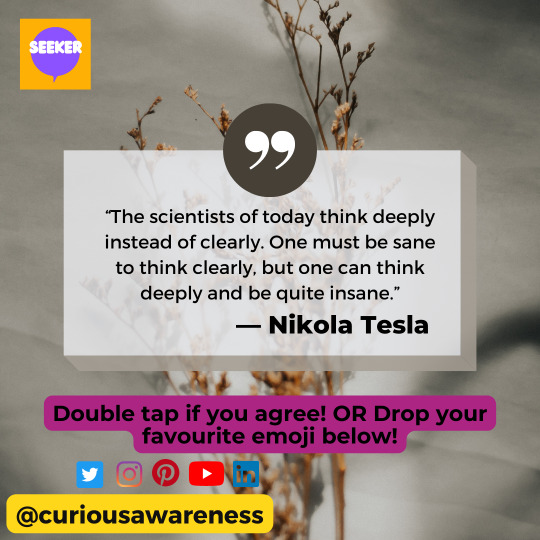
❤️✨🌟“My brain is only a receiver, in the Universe there is a core from which we obtain knowledge, strength and inspiration. I have not penetrated into the secrets of this core, but I know that it exists.”― Nikola Tesla🌟✨❤️
Our Instagram account:https://www.instagram.com/curiousawareness/
Our Linkedin account:https://www.linkedin.com/in/curiousawareness/
Our Twitter account: https://twitter.com/curiousawarenez
Our YouTube account:https://www.youtube.com/@curiousawareness/shorts
Our Pinterest account:https://in.pinterest.com/curiousawareness/_created/
Please leave a LIKE and stay tuned for more AMAZING content!
Tags
Meditation, Awareness, Psychology, Wellbeing, wellness, Health, Sleep, Wake up, Morning, Curious, Awareness, Seeker, Curiosity, Awareness, Motivation, Mindset.
Hashtags
#psychology#goal#goalsetting#meditation#psychologyfacts#mindset#mindfulness#learnings#mind#bodyandmind#wellness#wellbeing#health#lifepath#freedom#focus#attention#thought#thoughtprovoking#unique
You can visit our YouTube, Pinterest, Twitter, Linkedin accounts too. Links are given in the YouTube Banner.
#psychology#goal#goalsetting#meditation#psychologyfacts#mindset#mindfulness#learnings#mind#bodyandmind#wellness#wellbeing#health#lifepath#freedom#focus#attention#thought#thoughtprovoking#unique
6 notes
·
View notes
Text
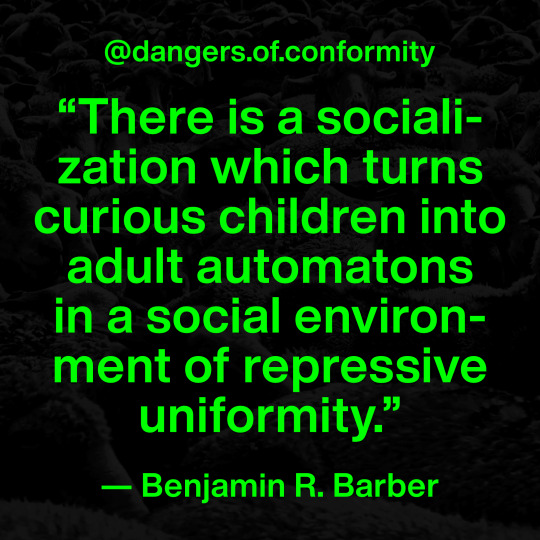
Reblog this to inspire your followers to resist mindless conformity 🎁
Non-conformity resources: https://linktr.ee/dangers.of.conformity 🧠
#conformity#nonconformity#non conformity#individuality#nonconformist#beyourself#be yourself#quotes#criticalthinking#critical thinking#nonconformists#herdmentality#herd mentality#sayings#aphorisms#quotations#selfreliance#self reliance#thoughtprovoking#thought provoking#quoteoftheday#quote of theday#foodforthought#food for thought#independentthinking#independent thinking#conformityquotes#conformity quotes#nonconformityquotes#nonconformity quotes
3 notes
·
View notes
Text
Don’t bother explaining everything all the time.
Some people aren’t supposed to get it.
Consciousthoughts
#my writing#poems and quotes#beautiful quote#thoughtprovoking#quotelovers#letting go#bad friends#moving on
27 notes
·
View notes
Photo

Let's take a moment to honor the sacrifice of our brave schoolchildren who lay down their lives to protect our right to bear arms.
#thoughtprovoking#sacrifice#irony#brave#schoolchildren#beararms#takeamoment#schoolshootings#sarcastic#gunrights#raiseapint#feelingsad#acrylic#painting#artoftheday#artists on tumblr#tumblrtarian#artwork#dailyartwork#outsiderart#lowbrowart#kunst#flommist#flomm#sadahirecoasters#handpaintedbeercoaster#beercoaster#beermat#perspective
2 notes
·
View notes
Text
hit me when you see it
it being the look on my face
when my eyes connect with his.
the look of love, of course though,
covering the ever growing seed of hate,
the burning and crackling flames of rage
and the ever so treacherous river of sadness.
it just being a look though.
a facade holding all the unholdable.
t.b. ; s. just a shout to the void
6 notes
·
View notes
Text
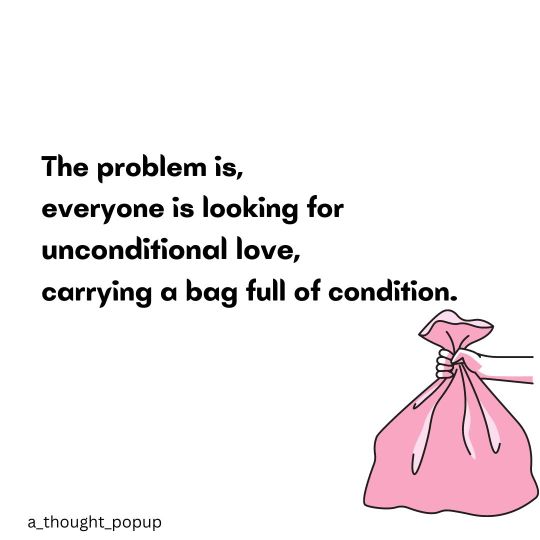
sooo... true! ask yourself can you really love someone with 'no expectation in return'? but yea! here we are not talking about loving someone out of kindness and compassion. love and kindness are two different thing.
2 notes
·
View notes
Quote
"October is about trees revealing colors they've hidden all year.
People have an October as well
J.M Storms
#octoberseason#octoberautumn#autumn season#newseason#Season Of Change#newbeginnings#new change#autumn vibes#autumm#jmstorm#october quotes#quoteoftheday#positivity#Thoughts#Life Quotations#thoughtprovoking#writers#writngs#thisseason
62 notes
·
View notes
